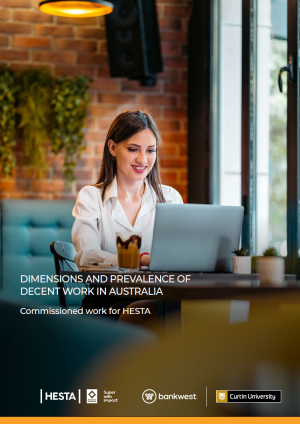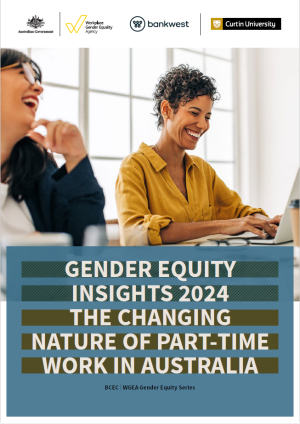Publications
Estimating the Standard Errors of Individual-Specific Parameters in Random Parameters Models
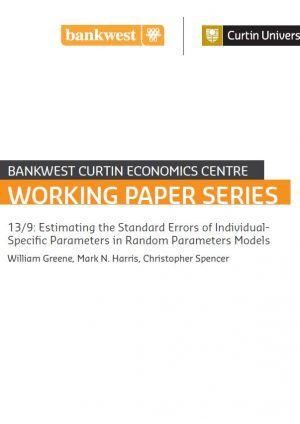 Abstract We consider the estimation of the standard errors of individual‐specific parameters calculated ex post from a non‐linear random parameters model. Our key contribution lies in introducing a simple method of appropriately calculating these standard errors, which explicitly takes into account the sampling variability... Read article
Abstract We consider the estimation of the standard errors of individual‐specific parameters calculated ex post from a non‐linear random parameters model. Our key contribution lies in introducing a simple method of appropriately calculating these standard errors, which explicitly takes into account the sampling variability... Read article
 Abstract We consider the estimation of the standard errors of individual‐specific parameters calculated ex post from a non‐linear random parameters model. Our key contribution lies in introducing a simple method of appropriately calculating these standard errors, which explicitly takes into account the sampling variability... Read article
Abstract We consider the estimation of the standard errors of individual‐specific parameters calculated ex post from a non‐linear random parameters model. Our key contribution lies in introducing a simple method of appropriately calculating these standard errors, which explicitly takes into account the sampling variability... Read article
Housing equity withdrawal: Uses,risks and barriers to alternative mechanisms in later life
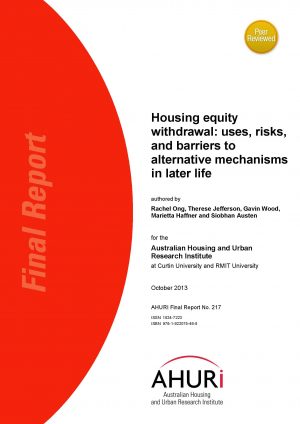 This project, funded by the Australian Housing and Urban Research Institute (AHURI), uncovers the uses, risks of and barriers to housing equity withdrawal (HEW) by older home owners aged 45 years and over via three alternative mechanisms: in situ mortgage... Read article
This project, funded by the Australian Housing and Urban Research Institute (AHURI), uncovers the uses, risks of and barriers to housing equity withdrawal (HEW) by older home owners aged 45 years and over via three alternative mechanisms: in situ mortgage... Read article
 This project, funded by the Australian Housing and Urban Research Institute (AHURI), uncovers the uses, risks of and barriers to housing equity withdrawal (HEW) by older home owners aged 45 years and over via three alternative mechanisms: in situ mortgage... Read article
This project, funded by the Australian Housing and Urban Research Institute (AHURI), uncovers the uses, risks of and barriers to housing equity withdrawal (HEW) by older home owners aged 45 years and over via three alternative mechanisms: in situ mortgage... Read article
The edges of home ownership
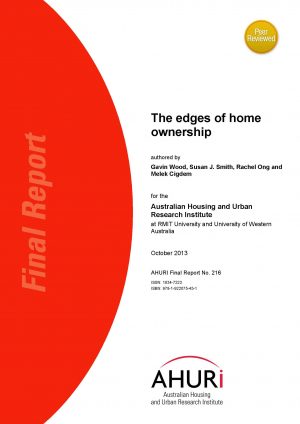 The edges of ownership form a neglected zone between the majority tenure, sustainable owner occupation, and the minority experience, long-term renting. In tenure-divided societies like Australia, the UK and the USA—where there is a stark financial, social and cultural divide... Read article
The edges of ownership form a neglected zone between the majority tenure, sustainable owner occupation, and the minority experience, long-term renting. In tenure-divided societies like Australia, the UK and the USA—where there is a stark financial, social and cultural divide... Read article
 The edges of ownership form a neglected zone between the majority tenure, sustainable owner occupation, and the minority experience, long-term renting. In tenure-divided societies like Australia, the UK and the USA—where there is a stark financial, social and cultural divide... Read article
The edges of ownership form a neglected zone between the majority tenure, sustainable owner occupation, and the minority experience, long-term renting. In tenure-divided societies like Australia, the UK and the USA—where there is a stark financial, social and cultural divide... Read article
An Intra-State Regional Framework for Analysing the Western Australian Economy
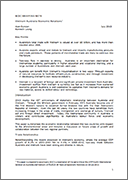 Western Australia is a diverse state with unique regions. Studies on the economy that ignore regional developments are likely to be hindered by a lack of the richness and variability inherent in the intra-state regions. This note introduces a framework... Read article
Western Australia is a diverse state with unique regions. Studies on the economy that ignore regional developments are likely to be hindered by a lack of the richness and variability inherent in the intra-state regions. This note introduces a framework... Read article
 Western Australia is a diverse state with unique regions. Studies on the economy that ignore regional developments are likely to be hindered by a lack of the richness and variability inherent in the intra-state regions. This note introduces a framework... Read article
Western Australia is a diverse state with unique regions. Studies on the economy that ignore regional developments are likely to be hindered by a lack of the richness and variability inherent in the intra-state regions. This note introduces a framework... Read article
Marginalised Australians: characteristics and predictors of exit over ten years 2001-10
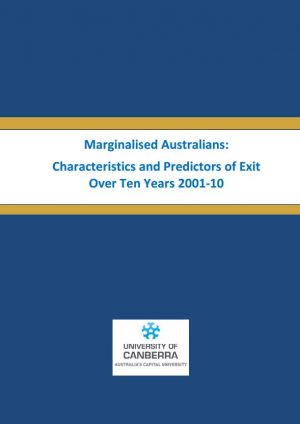 A decade ago a group of ‘marginalised’ Australians were identified; individuals who are characterised by a complex mix of financial, social, and mental health disadvantage. This project has followed up these individuals ten years later, and found that a majority... Read article
A decade ago a group of ‘marginalised’ Australians were identified; individuals who are characterised by a complex mix of financial, social, and mental health disadvantage. This project has followed up these individuals ten years later, and found that a majority... Read article
 A decade ago a group of ‘marginalised’ Australians were identified; individuals who are characterised by a complex mix of financial, social, and mental health disadvantage. This project has followed up these individuals ten years later, and found that a majority... Read article
A decade ago a group of ‘marginalised’ Australians were identified; individuals who are characterised by a complex mix of financial, social, and mental health disadvantage. This project has followed up these individuals ten years later, and found that a majority... Read article
‘Go West, Young Man…’
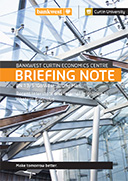 Key points Internal migration is a critical component of labour market flexibility. This report explores internal migration patterns in Australia, particularly over the last decade. Specifically, trends relating to East to West migration patterns are examined. Data from the latest... Read article
Key points Internal migration is a critical component of labour market flexibility. This report explores internal migration patterns in Australia, particularly over the last decade. Specifically, trends relating to East to West migration patterns are examined. Data from the latest... Read article
 Key points Internal migration is a critical component of labour market flexibility. This report explores internal migration patterns in Australia, particularly over the last decade. Specifically, trends relating to East to West migration patterns are examined. Data from the latest... Read article
Key points Internal migration is a critical component of labour market flexibility. This report explores internal migration patterns in Australia, particularly over the last decade. Specifically, trends relating to East to West migration patterns are examined. Data from the latest... Read article
Trends in Poverty and Inequality in Decentralising Indonesia
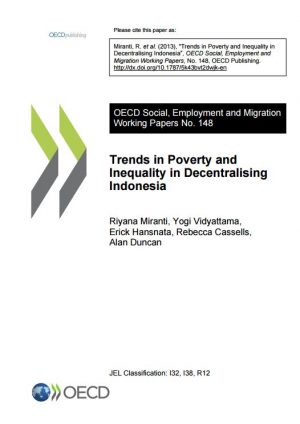 As one of the world’s largest emerging economies, Indonesia has experienced rapid economic growth and substantial reduction of poverty over the past three decades, particularly prior to the 1997-98 Asian Financial Crisis. After the crisis, Indonesia entered a new development... Read article
As one of the world’s largest emerging economies, Indonesia has experienced rapid economic growth and substantial reduction of poverty over the past three decades, particularly prior to the 1997-98 Asian Financial Crisis. After the crisis, Indonesia entered a new development... Read article
 As one of the world’s largest emerging economies, Indonesia has experienced rapid economic growth and substantial reduction of poverty over the past three decades, particularly prior to the 1997-98 Asian Financial Crisis. After the crisis, Indonesia entered a new development... Read article
As one of the world’s largest emerging economies, Indonesia has experienced rapid economic growth and substantial reduction of poverty over the past three decades, particularly prior to the 1997-98 Asian Financial Crisis. After the crisis, Indonesia entered a new development... Read article
Incorporating Space in the Theory of Endogenous Growth
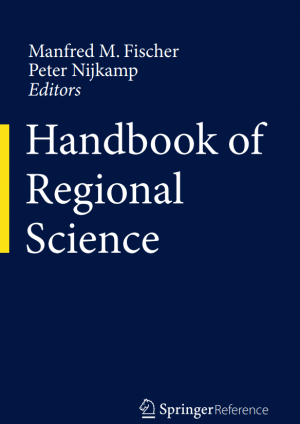 We describe how endogenous growth theory has now incorporated spatial factors. We also derive some of the policy implications of this new theory for growth and economic integration. We start by reviewing the product variety model of endogenous growth and... Read article
We describe how endogenous growth theory has now incorporated spatial factors. We also derive some of the policy implications of this new theory for growth and economic integration. We start by reviewing the product variety model of endogenous growth and... Read article
 We describe how endogenous growth theory has now incorporated spatial factors. We also derive some of the policy implications of this new theory for growth and economic integration. We start by reviewing the product variety model of endogenous growth and... Read article
We describe how endogenous growth theory has now incorporated spatial factors. We also derive some of the policy implications of this new theory for growth and economic integration. We start by reviewing the product variety model of endogenous growth and... Read article
Immigration and Political Instability
 Immigration may adversely affect political stability if immigrants are perceived unfavourably by host country populations. Using a large sample of countries this study confirms that a higher immigrant share of a population is associated with decrease in the level of... Read article
Immigration may adversely affect political stability if immigrants are perceived unfavourably by host country populations. Using a large sample of countries this study confirms that a higher immigrant share of a population is associated with decrease in the level of... Read article
 Immigration may adversely affect political stability if immigrants are perceived unfavourably by host country populations. Using a large sample of countries this study confirms that a higher immigrant share of a population is associated with decrease in the level of... Read article
Immigration may adversely affect political stability if immigrants are perceived unfavourably by host country populations. Using a large sample of countries this study confirms that a higher immigrant share of a population is associated with decrease in the level of... Read article
Advantages of Non-Normality in Testing Cointegration Rank
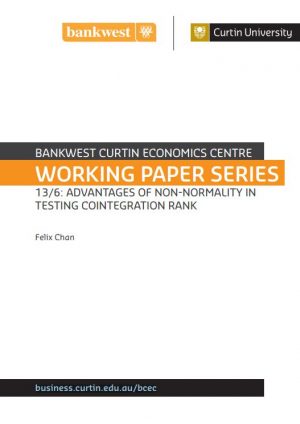 Abstract Since the seminal work of Engle and Granger (1987) and Johansen (1988), testing for cointegration has become standard practice in analysing economic and financial time series data. Many of the techniques in cointegration analysis require the assumption of normality, which may... Read article
Abstract Since the seminal work of Engle and Granger (1987) and Johansen (1988), testing for cointegration has become standard practice in analysing economic and financial time series data. Many of the techniques in cointegration analysis require the assumption of normality, which may... Read article
 Abstract Since the seminal work of Engle and Granger (1987) and Johansen (1988), testing for cointegration has become standard practice in analysing economic and financial time series data. Many of the techniques in cointegration analysis require the assumption of normality, which may... Read article
Abstract Since the seminal work of Engle and Granger (1987) and Johansen (1988), testing for cointegration has become standard practice in analysing economic and financial time series data. Many of the techniques in cointegration analysis require the assumption of normality, which may... Read article
Econometric Modelling of Social Bads
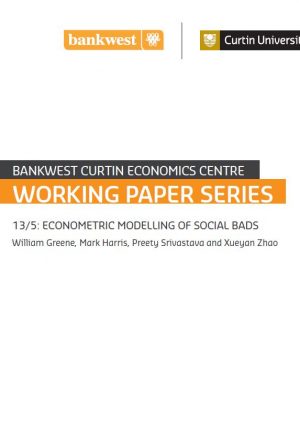 Abstract When modeling “social bads”, such as illegal drug consumption, researchers are often faced with a dependent variable characterised by an “excessive” amount of zero observations. Building on the recent literature on hurdle and double-hurdle models, we propose a double-inflated modeling framework, where the... Read article
Abstract When modeling “social bads”, such as illegal drug consumption, researchers are often faced with a dependent variable characterised by an “excessive” amount of zero observations. Building on the recent literature on hurdle and double-hurdle models, we propose a double-inflated modeling framework, where the... Read article
 Abstract When modeling “social bads”, such as illegal drug consumption, researchers are often faced with a dependent variable characterised by an “excessive” amount of zero observations. Building on the recent literature on hurdle and double-hurdle models, we propose a double-inflated modeling framework, where the... Read article
Abstract When modeling “social bads”, such as illegal drug consumption, researchers are often faced with a dependent variable characterised by an “excessive” amount of zero observations. Building on the recent literature on hurdle and double-hurdle models, we propose a double-inflated modeling framework, where the... Read article
Brain Drain or Brawn Drain?
 Studies on the determinants of migration provide evidence that distance has a strong negative effect. That is, the farther the region is, the lower the probability that people would like to migrate to. However, Western Australia, whose capital city is... Read article
Studies on the determinants of migration provide evidence that distance has a strong negative effect. That is, the farther the region is, the lower the probability that people would like to migrate to. However, Western Australia, whose capital city is... Read article
 Studies on the determinants of migration provide evidence that distance has a strong negative effect. That is, the farther the region is, the lower the probability that people would like to migrate to. However, Western Australia, whose capital city is... Read article
Studies on the determinants of migration provide evidence that distance has a strong negative effect. That is, the farther the region is, the lower the probability that people would like to migrate to. However, Western Australia, whose capital city is... Read article

